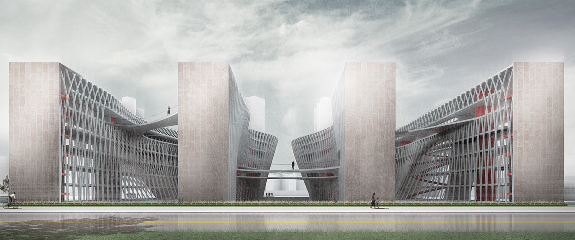
A school designed for a prisoner
Would a prison-school combination solve or sustain the problem of high incarceration rates?
A Harvard student's thesis started with a problem—the United States' high incarceration rate of non-violent drug criminals. The solution grew into something innovative and controversial—a prison and school, or "PriSchool".
Glen Santayana of Harvard University's Graduate School of Design wrote his master in architecture thesis on a building that could mean a second chance for prisoners or profits for a booming private industry.
The concept focused on the outflow of prisoners and recidivism, or those who return to prison after being released. Santayana argued that lowering recidivism rates could save the state thousands of dollars. Of all inmates released from prison, 67 percent are re-incarcerated within 3 years, according to the U.S. Bureau of Justice. To save money, Santayana did not attack the influx of prisoners, but what happens in the prison itself.
The "War on Drugs", Santayana acknowledged, created a massive boom in prison population in one decade. Of all prisoners in America, 92 percent wound up behind bars for non-violent offenses. Yet Santayana's idea did not suggest a change in drug policy—it relied on it. His entire prison-school would operate based on a consistent stream of non-violent drug offenders, often from neighborhoods with few economic and educational opportunities. To address a cycle caused in part by lack of quality education, Santayana suggested investing in a prison-school rather than a preschool.
The idea is simple in concept and complex in design. "PriSchool" would be a prison for non-violent drug offenders and a school for criminology and criminal justice students. A crossover would facilitate inmate-student interaction and learning for both parties.
In his thesis, Santayana drew a connection between those in prison and those in college. The median for college age students (20-24 years old) is the same as the highest age group in prison. He also pointed out that state spending per prison inmate is similar to college tuition.
The thesis did not mention the socioeconomic gap between youth in college and youth in prison. The disparities begin early in a child's life. The American Education Research Association released a study that found that students who cannot read on grade level by third grade are four times less likely to graduate high school before turning 19-years-old. According to the National Dropout Prevention Center, 75 percent of inmates are high school dropouts.
The ACLU reports that African Americans are less likely to read at grade level by third grade, and incarcerated at ten times the rate of whites (despite similar rates of drug offenses for each group), while white students graduate high school and attend college at a higher rate than African American students.
While some inmates would benefit from the educational setup, the investors, building staff, contractors and outside students would benefit more from maintaining a cycle of imprisonment, whether generational or individual. Half the building would rely on admitting more prisoners, or it would close altogether, costing money to those with invested interest.
Even if "PriSchool" assisted prisoners in finishing their education, academic skills are not the only factors to finding a job and reintegrating oneself into society once released. Most states still allow employers to ask for criminal history on applications, preventing ex-convicts from achieving employment despite credentials. Even in Philadelphia, where the practice is banned, the law is not always enforced. "PriSchool" may be built on a philosophical foundation that everyone deserves a second chance, but the proposal ignores the issue that not everyone is given a first one, whether as children or as adults.
For now, "PriSchool" remains the idea of a graduate student. But as the number of private prisons continues to grow, the reality of a prison-school may not be that far off.









LEAVE A COMMENT:
Join the discussion! Leave a comment.